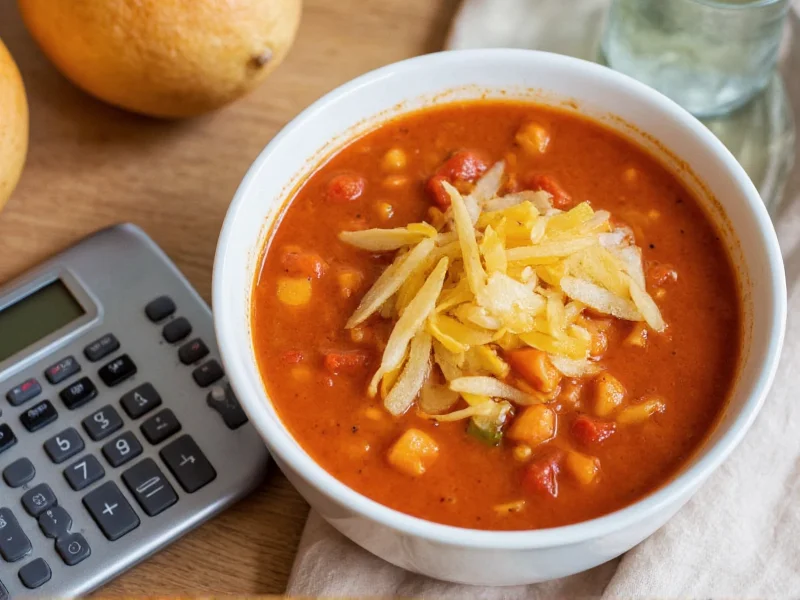When preparing soup, timing directly impacts both texture and nutritional value. Many home cooks struggle with determining exactly how long to cook soup for optimal results, leading to either mushy vegetables or underdeveloped flavors. This guide provides a practical framework for calculating precise cooking durations based on your specific ingredients and cooking method.
Factors That Determine Soup Cooking Time
Soup preparation isn't one-size-fits-all. Several variables affect the ideal soup simmering duration calculator for your recipe:
- Type of soup base - Broth, cream, tomato, or pureed foundations require different treatment
- Primary ingredients - Meat, poultry, seafood, legumes, and vegetables each have unique cooking requirements
- Cooking equipment - Stovetop, slow cooker, pressure cooker, or Instant Pot significantly alter timeframes
- Desired consistency - Chunky vs. smooth textures affect necessary cooking duration
- Batch size - Larger quantities generally require slightly longer cooking times
Soup Time Calculation Framework
Instead of searching for a generic soup cooking time calculator tool, use this adaptable framework that accounts for your specific ingredients:
- Establish your base cooking time based on soup category
- Add time for dense ingredients like root vegetables or dried beans
- Subtract time for delicate ingredients like leafy greens or seafood
- Factor in your cooking method (see conversion chart below)
- Include resting time for flavors to meld (15-30 minutes off-heat)
| Soup Type | Base Cooking Time | Key Ingredients | Critical Timing Notes |
|---|---|---|---|
| Clear Broth Soups | 20-30 minutes | Vegetables, herbs, lean meats | Add delicate vegetables in last 5-10 minutes |
| Cream-Based Soups | 25-40 minutes | Dairy, potatoes, mushrooms | Never boil after adding dairy; maintain gentle simmer |
| Bean/Legume Soups | 45-90 minutes | Dried beans, lentils, peas | Soak dried beans first; add acid (tomatoes) only after softening |
| Hearty Stews/Chowders | 60-120 minutes | Tougher meats, root vegetables | Low and slow cooking develops flavor; meat should pull apart easily |
| Quick Vegetable Soups | 15-25 minutes | Fresh vegetables, herbs | Cook vegetables just until tender-crisp to preserve nutrients |
Equipment-Specific Time Adjustments
Your cooking method dramatically affects how many hours to cook soup. Use this conversion guide when adapting recipes:
- Stovetop (standard): Follow base cooking times as listed
- Slow cooker: Multiply stovetop time by 3-4x on LOW setting, or 1.5-2x on HIGH
- Pressure cooker/Instant Pot: Reduce time to 1/3 of stovetop duration plus 10-15 minutes for pressure build/release
- Oven: Similar to stovetop but check 10-15 minutes before completion
For example, a beef stew requiring 90 minutes on stovetop would need approximately 4-6 hours on LOW in a slow cooker, or about 35-40 minutes total in a pressure cooker.
Ingredient-Specific Timing Considerations
Certain ingredients require precise timing to achieve the best results in your soup preparation time calculator calculations:
- Root vegetables (carrots, potatoes, parsnips): Add at beginning for soft texture, or 15-20 minutes before end for firmer bite
- Leafy greens (spinach, kale): Stir in during last 5 minutes of cooking
- Dairy/cream: Never boil; add near end and maintain gentle simmer below 180°F (82°C)
- Dried beans/lentils: Require 45-90 minutes; add acidic ingredients only after softening
- Tough meats (chuck, shank): Need 60-120 minutes to become tender
- Seafood: Add delicate fish 5-8 minutes before serving; shellfish 3-5 minutes
Signs Your Soup Has Reached Perfect Cooking Time
Instead of relying solely on the clock for your soup cooking duration calculator, watch for these visual and textural indicators:
- Vegetables should be tender but still hold their shape (except for pureed soups)
- Meats should pull apart easily with a fork (for stews) or reach safe internal temperatures
- Liquid should be properly reduced - soups shouldn't be watery but also not overly thick
- Aroma will deepen and become more complex as flavors meld
- Taste test should reveal balanced flavors with no raw ingredient tastes
Remember that soup continues to cook from residual heat after turning off the burner. For best results, remove soup from heat 5 minutes before it reaches your desired doneness, then let it rest covered for 15-30 minutes. This resting period allows flavors to fully integrate without overcooking ingredients.
Common Timing Mistakes and How to Avoid Them
Many home cooks make these timing errors when following a soup simmer time calculator:
- Boiling cream-based soups - Causes curdling; maintain gentle simmer below boiling point
- Adding all ingredients at once - Dense ingredients need head start over delicate ones
- Skipping the resting period - Flavors need time to meld after cooking stops
- Over-relying on timers - Visual and taste cues matter more than strict timing
- Not accounting for pot size - Wider pots reduce liquid faster than narrow ones
For vegetable-heavy soups, consider a staggered approach: add harder vegetables first, then medium-density ones, and delicate greens at the very end. This ensures all components reach perfect doneness simultaneously.
Advanced Timing Considerations
Professional chefs understand that optimal soup cooking duration calculation involves more than just heat application:
- Flavor development timeline: Most soups benefit from 15-30 minutes of resting after cooking to allow flavors to meld
- Overnight refrigeration: Many soups taste better the next day as ingredients continue to absorb flavors
- Reheating considerations: Add delicate ingredients fresh when reheating frozen or refrigerated soup
- Seasoning timing: Salt early for meat dishes, but add near end for vegetable soups to prevent over-reduction
For best results with meat-based soups, consider a two-stage cooking process: brown meats thoroughly first, then simmer gently for extended periods. This develops complex flavors while ensuring proper food safety.











 浙公网安备
33010002000092号
浙公网安备
33010002000092号 浙B2-20120091-4
浙B2-20120091-4